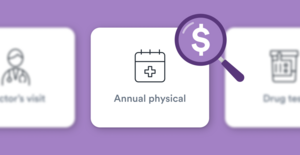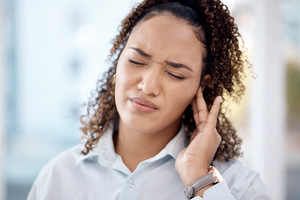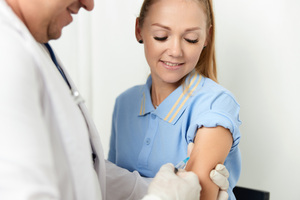Key points
- Fainting, or syncope, is a temporary loss of consciousness due to a disruption of blood flow to the brain.
- Common causes of fainting include dehydration, low blood sugar, sudden drop in blood pressure, or emotional stress.
- Recognizing early warning signs such as dizziness, lightheadedness, and sudden sweating can help prevent fainting.
- If someone faints, it's important to ensure they're lying down, elevate their legs, and seek medical attention if they don't regain consciousness quickly.
- Fainting can lead to injuries, heart arrhythmias, seizures, and hazards if it occurs while driving, so it's crucial to seek medical help if there are injuries, multiple fainting incidents, prolonged unconsciousness, or if certain symptoms accompany the fainting.

Fainting, also known as “syncope” or “passing out”, is a sudden and temporary loss of consciousness — usually caused by a disruption of blood flow to the brain, according to the Mayo Clinic. They note that this can occur due to various reasons such as dehydration, low blood sugar, sudden drop in blood pressure, or emotional stress. In response to a fainting episode, it is important to ensure the person is lying down and elevate their legs to help restore blood flow to the brain. If the person does not regain consciousness quickly, it is crucial to seek medical attention promptly.
Continue reading to learn more about the causes of fainting and what to do if it happens.
Fainting 101
Fainting is a sudden and temporary loss of consciousness caused by a temporary decrease in blood flow to the brain, and may also be called:
-
Passing out
-
Loss of consciousness
-
Syncope
The Cleveland Clinic notes that fainting can occur due to a variety of factors such as:
-
Dehydration
-
Low blood sugar
-
Sudden drop in blood pressure
-
Emotional stress
Understanding the underlying causes and appropriate responses to fainting can help individuals effectively manage and prevent fainting — and is an important first aid skill for everyone.
Early Warning Signs and Symptoms of Fainting
Before a fainting episode, individuals may experience some warning signs and symptoms that can serve as an alert to sit or lie down and take preventative measures, according to the Cleveland Clinic.
By recognizing these early indicators, you may be able to reduce the risks associated with a sudden loss of consciousness. The common symptoms that typically precede fainting, can vary from person to person, according to the Cleveland Clinic, but often include sensations of discomfort or distress along any one or more of the following symptoms:
-
Dizziness
-
Lightheadedness
-
Sudden sweating accompanied by a sensation of warmth
-
Nausea or vomiting
-
Paleness of the skin
-
Feelings of stress or anxiety
-
General weakness
-
Skin that feels cold and clammy to the touch
Top Reasons Why People Faint
Fainting can be a puzzling and often alarming event, both for the person who experiences it and for those who witness it. Understanding the top reasons why people faint is essential for identifying potential triggers and taking steps to prevent future occurrences.
Fainting is not a disease but rather a symptom of many possible conditions and situations that disrupt the normal flow of blood to the brain, according to the Cleveland Clinic. Below, we’ll explain the various factors that the Cleveland Clinic lists can lead to a fainting spell — ranging from benign to serious underlying health issues:
-
Carotid sinus syncope: A hypersensitive reflex in the carotid sinus, located in the neck, that can cause fainting when pressure is applied (e.g., from tight collars or turning the head).
-
Vasovagal syncope: The most common type of fainting episode, often triggered by pain, fear, prolonged standing, or emotional distress, leading to a sudden drop in heart rate and blood pressure.
-
Cardiac syncope: Caused by various heart conditions, including arrhythmias or structural heart disease, that affect blood flow and can lead to loss of consciousness.
-
Medications: Certain drugs, especially those that lower blood pressure or heart rate, can contribute to fainting spells as a side effect.
-
Neurological conditions: Disorders such as epilepsy or transient ischemic attacks (TIAs) can also manifest with fainting episodes.
-
Dehydration/Overheating: Insufficient fluid intake or exposure to high temperatures can lead to dehydration and overheating, both of which can precipitate fainting.
-
Blood Sugar Fluctuations: Hypoglycemia (low blood sugar) can cause fainting, particularly in individuals with diabetes or those who have not eaten for an extended period.
-
Unknown causes: In some cases, the exact cause of fainting may not be determined, even after medical evaluation.
Common Activities That Can Trigger Fainting
Fainting can be an unexpected and often frightening experience that may occur during various everyday activities. The Cleveland Clinic explains that certain actions and behaviors are known to trigger fainting episodes — and being aware of these can help you avoid or prepare for potential situations where fainting could occur.
Below are some common activities and circumstances that the Cleveland Clinic notes are associated with an increased risk of fainting, emphasizing the importance of recognizing and responding to the body's warning signals.
-
Substance use: The consumption of alcohol, drugs, or even tobacco can lead to fainting due to their effects on blood pressure, heart rate, and overall cardiovascular function.
-
Rapidly standing up: Moving quickly from a sitting or lying position to standing, known as orthostatic hypotension, can cause a temporary drop in blood pressure and lead to fainting.
-
Hyperventilation: Breathing too quickly or deeply, often in response to anxiety or panic, can result in a decrease in carbon dioxide levels in the blood, which may trigger fainting.
-
Overexertion: Engaging in intense physical activity, especially in hot weather or without adequate hydration, can lead to exhaustion and fainting.
-
Missing meals: Skipping meals can lead to low blood sugar levels, which is a common trigger for fainting, particularly in individuals who are more sensitive to changes in their blood glucose levels.
What to Do If Someone Faints?
Fainting can be caused by a variety of factors, and while it is often harmless, it can sometimes indicate a more serious condition, according to the Mayo Clinic. So when someone faints, it is important to respond quickly and effectively to ensure their safety and well-being.
Knowing the proper steps to take when someone loses consciousness can make a significant difference in their recovery and health outcomes. Below is a step-by-step guide on what to do if you encounter someone who has fainted, according to the Mayo Clinic and the Red Cross:
Clear the Airway
Ensure the person's airway is not obstructed by tilting their head back and checking for any obstructions in the mouth or throat.
Breathing Check
Confirm the person is breathing by looking for chest movements, listening for breath sounds, and feeling for breath on your cheek.
Heartbeat Verification
Make sure their heart is beating by checking their pulse either at the wrist or neck.
Emergency Response
Call 911 or get medical help immediately if there are injuries if the person does not wake up quickly, or if this is their first fainting episode.
Start CPR
Begin CPR if there's no breathing or pulse, following the proper guidelines for chest compressions and rescue breaths.
Apply AED
Have someone find an automated external defibrillator (AED) if necessary, especially if you suspect the fainting may be related to a cardiac issue and CPR is being performed.
While fainting itself is often not a serious medical event, according to the Mayo Clinic, the reasons and potential complications from fainting can be serious. They note that some complications from untreated fainting are:
-
Injuries from falls, including lacerations and head trauma
-
Heart arrhythmias if passing out is caused by a cardiac problem
-
Seizures caused by underlying problems such as low blood sugar
-
Hazards if the loss of consciousness happens while driving a vehicle or machinery
Determining When to Get Medical Help for Fainting
Fainting can be an isolated incident for many individuals, but in certain circumstances, it warrants further medical evaluation to rule out more serious underlying conditions, according to the Cleveland Clinic. They note that it's important to recognize when a simple fainting spell crosses the threshold into a potentially hazardous event that requires a healthcare professional's attention.
The following are various scenarios and accompanying factors that the Cleveland Clinic notes should prompt you to seek medical help for yourself or someone else who has fainted. These indicators are essential for ensuring the safety and well-being of anyone who experiences syncope.
-
If the person has sustained injuries, especially significant ones like fractures or a head injury, medical attention is necessary.
-
Syncope that occurs during or immediately after physical activity could be indicative of heart-related issues and should be evaluated by a healthcare provider.
-
Multiple fainting incidents may suggest an underlying medical condition that requires diagnosis and management.
-
If consciousness is not regained within a few minutes, or if the person appears to be exceptionally disoriented after coming to, medical help should be sought.
-
A fall that results in a blow to the head can lead to concussions or other serious injuries, necessitating immediate medical care.
-
Experiencing more than one fainting episode within a short time frame could signal a more serious problem.
-
Individuals with known heart conditions, diabetes, or other significant health issues should seek medical attention after a fainting spell since it could be related to their underlying condition.
-
Symptoms such as chest pain, severe headache, shortness of breath, or palpitations accompanying a fainting episode are red flags that require prompt medical evaluation.
For a medical emergency, such as fainting, dial 911 or visit your closest emergency room immediately.
FAQs
What is fainting?
Fainting, also known as syncope, is a temporary loss of consciousness usually caused by a disruption of blood flow to the brain.
What are the common causes of fainting?
Common causes of fainting include dehydration, low blood sugar, a sudden drop in blood pressure, or emotional stress.
What are some early warning signs of fainting?
Early warning signs of fainting can include dizziness, lightheadedness, sudden sweating, nausea or vomiting, paleness of the skin, feelings of stress or anxiety, general weakness, and skin that feels cold and clammy to the touch.
What should I do if someone faints?
If someone faints, ensure they are lying down and elevate their legs to help restore blood flow to the brain. If they do not regain consciousness quickly, seek medical attention promptly.
When should I seek medical help for fainting?
You should seek medical help for fainting if the person has sustained injuries, if the fainting occurs during or immediately after physical activity, if there are multiple fainting incidents, if consciousness is not regained within a few minutes, or if there are symptoms such as chest pain, severe headache, shortness of breath, or palpitations accompanying the fainting episode.









